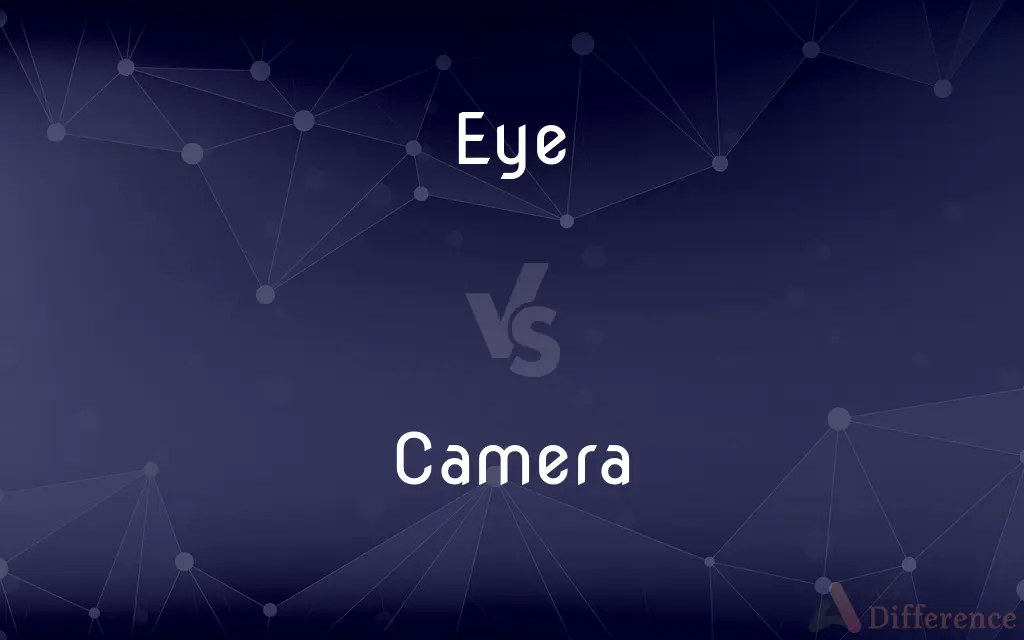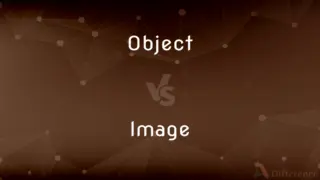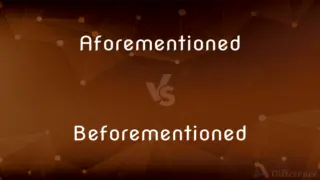Eye vs. Camera — What's the Difference?
Edited by Tayyaba Rehman — By Urooj Arif — Updated on May 16, 2024
The eye is a biological organ that enables vision through complex physiological processes, while a camera is a technological device that captures images using lenses and sensors or film.

Difference Between Eye and Camera
Table of Contents
ADVERTISEMENT
Key Differences
The eye, a biological organ, enables vision by detecting light and converting it into neural signals. It consists of various parts, including the cornea, lens, retina, and optic nerve, which work together to focus light and transmit visual information to the brain. A camera, on the other hand, is a technological device designed to capture and record images. It uses a lens to focus light onto a photosensitive surface, such as film or a digital sensor. Cameras can be adjusted manually or automatically to control exposure, focus, and other settings, enabling the capture of clear and detailed images.
The eye's ability to perceive depth, motion, and color in real time is facilitated by its connection to the brain, which processes visual information rapidly. This biological process allows for continuous adaptation to changing environments. Cameras, however, capture static images or videos that are stored and can be reproduced later. While they can mimic some aspects of human vision, such as depth of field and color balance, they lack the dynamic adaptability and instantaneous processing of the human eye.
The primary function of the eye is to provide vision and spatial awareness, critical for daily activities and survival. Cameras, however, are tools for capturing and preserving visual information, used in various fields such as photography, filmmaking, surveillance, and scientific research.
Comparison Chart
Type
Biological organ
Technological device
Function
Enables vision through light detection
Captures and records images
ADVERTISEMENT
Components
Cornea, lens, retina, optic nerve
Lens, sensor/film, shutter, aperture
Light Detection
Photoreceptors in the retina
Photosensitive film or digital sensor
Image Processing
Neural processing by the brain
Electronic or chemical processing
Adaptability
Dynamic adjustment to light and focus
Adjustable settings (manual/automatic)
Depth Perception
Binocular vision and brain interpretation
Depth of field through lens settings
Real-Time Adjustment
Continuous adaptation to environment
Pre-set adjustments for each shot
Primary Use
Vision and spatial awareness
Image and video capture
Compare with Definitions
Eye
A biological organ that detects light and allows vision.
The human eye can adjust to low light conditions, enhancing night vision.
Camera
Can be adjusted to control exposure, focus, and other settings.
He adjusted the camera's aperture and shutter speed to get the perfect shot.
Eye
Contains a lens and retina to focus and process light.
The lens of the eye changes shape to focus on objects at different distances.
Camera
A device that captures images using lenses and sensors or film.
She used a digital camera to take high-resolution photos of the landscape.
Eye
Adapts to varying light conditions dynamically.
The eye's pupil dilates in dim light to allow more light in.
Camera
Focuses light onto a photosensitive surface to record images.
The camera's lens focuses light onto the sensor to capture a sharp image.
Eye
Eyes are organs of the visual system. They provide animals with vision, the ability to receive and process visual detail, as well as enabling several photo response functions that are independent of vision.
Camera
Mimics some aspects of human vision but lacks real-time processing.
The camera captured the sunset beautifully, but it couldn't match the eye's real-time perception of colors.
Eye
An organ of vision or of light sensitivity.
Camera
Used for photography, filmmaking, surveillance, and research.
Security cameras are installed to monitor and record activities in public areas.
Eye
Either of a pair of hollow structures located in bony sockets of the skull, functioning together or independently, each having a lens capable of focusing incident light on an internal photosensitive retina from which nerve impulses are sent to the brain; the vertebrate organ of vision.
Camera
A camera is an optical instrument that captures a visual image. At their most basic, cameras are sealed boxes (the camera body) with a small hole (the aperture) that allows light in to capture an image on a light-sensitive surface (usually photographic film or a digital sensor).
Eye
The external, visible portion of this organ together with its associated structures, especially the eyelids, eyelashes, and eyebrows.
Camera
A usually portable device containing a photosensitive surface that records images through a lens.
Eye
The pigmented iris of this organ.
Camera
A camera obscura.
Eye
The faculty of seeing; vision.
Camera
Pl. cam·er·ae (-ə-rē) A judge's private chamber.
Eye
The ability to make intellectual or aesthetic judgments:has a good eye for understated fashion.
Camera
A device for taking still or moving pictures or photographs.
Eye
A way of regarding something; a point of view:To my eye, the decorations are excellent.
Camera
The viewpoint in a three-dimensional game or simulation.
Eye
Attention:The lavish window display immediately got my eye.
Camera
A vaulted room.
Eye
Watchful attention or supervision:always under his boss's eye; kept an eye on her valuables.
Camera
A judge's private chamber, where cases may be heard in camera.
Eye
An opening in a needle.
Camera
A chamber, or instrument having a chamber. Specifically: The camera obscura when used in photography. See Camera, and Camera obscura.
Eye
The aperture of a camera.
Camera
Equipment for taking photographs (usually consisting of a lightproof box with a lens at one end and light-sensitive film at the other)
Eye
A loop, as of metal, rope, or thread.
Camera
Television equipment consisting of a lens system that focuses an image on a photosensitive mosaic that is scanned by an electron beam
Eye
A circular marking on a peacock's feather.
Eye
Chiefly Southern US The round flat cover over the hole on the top of a wood-burning stove.Also called regionallycap1, griddle.
Eye
A photosensitive device, such as a photoelectric cell.
Eye
A bud on a twig or tuber:the eye of a potato.
Eye
The often differently colored center of the corolla of some flowers.
Eye
(Meteorology)The circular area of relative calm at the center of a cyclone.
Eye
The center or focal point of attention or action:right in the eye of the controversy.
Eye
(Informal)A detective, especially a private investigator.
Eye
A choice center cut of meat, as of beef:eye of the round.
Eye
To look at:eyed the passing crowd with indifference.
Eye
To watch closely:eyed the shark's movements.
Eye
To supply with an eye.
Eye
An organ through which animals see (perceive surroundings via light).
Bright lights really hurt my eyes.
Eye
The visual sense.
The car was quite pleasing to the eye, but impractical.
Eye
The iris of the eye, being of a specified colour.
Brown, blue, green, hazel eyes.
Natalie’s brown eyes looked into Jim’s blue eyes, and the girl and boy flirted.
Eye
Attention, notice.
That dress caught her eye.
Eye
The ability to notice what others might miss.
He has an eye for talent.
Eye
A meaningful stare or look.
She was giving him the eye at the bar.
When the car cut her off, she gave him the eye.
Eye
A private eye: a privately hired detective or investigator.
Eye
A hole at the blunt end of a needle through which thread is passed.
Eye
The oval hole of an axehead through which the axehandle is fitted.
Eye
A fitting consisting of a loop of metal or other material, suitable for receiving a hook or the passage of a cord or line.
Eye
The relatively clear and calm center of a hurricane or other cyclonic storm.
Eye
A mark on an animal, such as a peacock or butterfly, resembling a human eye.
Eye
The dark spot on a black-eyed pea.
Eye
A reproductive bud in a potato.
Eye
(informal) The dark brown center of a black-eyed Susan flower.
Eye
A loop forming part of anything, or a hole through anything, to receive a rope, hook, pin, shaft, etc.; for example, at the end of a tie bar in a bridge truss, through a crank, at the end of a rope, or through a millstone.
Eye
That which resembles the eye in relative importance or beauty.
Eye
Tinge; shade of colour.
Eye
One of the holes in certain kinds of cheese.
Eye
(architecture) The circle in the centre of a volute.
Eye
(typography) The enclosed counter (negative space) of the small letter e.
Eye
(game of go) An empty point or group of points surrounded by one player's stones.
Eye
View or opinion.
This victory will make us great in the eyes of the world.
Eye
(transitive) To carefully or appraisingly observe (someone or something).
After eyeing the document for half an hour, she decided not to sign it.
They went out and eyed the new car one last time before deciding.
Eye
To appear; to look.
Eye
(transitive) To remove the reproductive buds from (potatoes).
Eye
(transitive) To allow (fish eggs) to develop so that the black eye spots are visible.
Eye
A brood; as, an eye of pheasants.
Eye
The organ of sight or vision. In man, and the vertebrates generally, it is properly the movable ball or globe in the orbit, but the term often includes the adjacent parts. In most invertebrates the eyes are immovable ocelli, or compound eyes made up of numerous ocelli. See Ocellus.
Eye
The faculty of seeing; power or range of vision; hence, judgment or taste in the use of the eye, and in judging of objects; as, to have the eye of a sailor; an eye for the beautiful or picturesque.
Eye
The action of the organ of sight; sight, look; view; ocular knowledge; judgment; opinion.
In my eye, she is the sweetest lady that I looked on.
Eye
The space commanded by the organ of sight; scope of vision; hence, face; front; the presence of an object which is directly opposed or confronted; immediate presence.
We shell express our duty in his eye.
Her shell your hear disproved to her eyes.
Eye
Observation; oversight; watch; inspection; notice; attention; regard.
Booksellers . . . have an eye to their own advantage.
Eye
That which resembles the organ of sight, in form, position, or appearance
Eye
That which resembles the eye in relative importance or beauty.
Athens, the eye of Greece, mother of arts.
Eye
Tinge; shade of color.
Red with an eye of blue makes a purple.
Eye
To fix the eye on; to stare at; to look on; to view; to observe; particularly, to observe or watch narrowly, or with fixed attention; to hold in view.
Eye me, blest Providence, and square my trialTo my proportioned strength.
Eye
To appear; to look.
My becomings kill me, when they do notEye well to you.
Eye
The organ of sight
Eye
Good discernment (either with the eyes or as if with the eyes);
She has an eye for fresh talent
He has an artist's eye
Eye
Attention to what is seen;
He tried to catch her eye
Eye
An area that is approximately central within some larger region;
It is in the center of town
They ran forward into the heart of the struggle
They were in the eye of the storm
Eye
A small hole or loop (as in a needle);
The thread wouldn't go through the eye
Eye
Look at
Eye
Transmits visual information to the brain via the optic nerve.
The retina converts light into neural signals sent to the brain for image processing.
Eye
Capable of perceiving depth, motion, and color.
The eye's ability to perceive depth helps in estimating distances.
Common Curiosities
How does the eye focus on objects?
The eye uses a flexible lens that changes shape to focus light on the retina, allowing for clear vision at different distances.
How does a camera focus on objects?
A camera focuses light using a lens that can be adjusted manually or automatically to ensure sharp images on the sensor or film.
Can a camera adjust to different light conditions like the eye?
Cameras can adjust to different light conditions through settings like ISO, aperture, and shutter speed, but they lack the dynamic range and adaptability of the human eye.
How do cameras achieve depth of field?
Cameras achieve depth of field through lens settings, such as aperture size, which controls the range of distances in focus.
What is depth perception in the eye?
Depth perception is the eye's ability to perceive the distance of objects, achieved through binocular vision and brain interpretation.
Do eyes have a built-in image stabilization like some cameras?
While eyes do not have mechanical stabilization, the brain can compensate for minor movements, providing a stable visual experience.
What role does the sensor play in a camera?
The sensor in a camera captures light and converts it into an electronic signal, which is then processed to form an image.
How do cameras handle rapid changes in light conditions?
Cameras can adjust exposure settings automatically, but they may not adapt as seamlessly as the human eye to rapid light changes.
What is the primary difference between an eye and a camera?
The eye is a biological organ that enables vision through physiological processes, while a camera is a technological device designed to capture and record images.
What role does the retina play in vision?
The retina contains photoreceptors that detect light and convert it into neural signals for the brain to process, enabling vision.
How do eyes handle rapid changes in light conditions?
Eyes adjust to rapid changes in light conditions through the dilation and contraction of the pupils and changes in photoreceptor sensitivity.
Can the eye's vision be recorded for later viewing?
The eye's vision cannot be recorded directly; however, visual experiences can be captured through cameras and other recording devices.
Can cameras replicate the color perception of the eye?
Cameras can capture a wide range of colors, but they often require post-processing to match the nuanced color perception of the human eye.
What are common uses for cameras that differ from the eye's function?
Cameras are used for capturing and preserving images and videos, scientific research, surveillance, and artistic expression, whereas the eye's primary function is providing vision and spatial awareness.
What is the dynamic range of the eye compared to a camera?
The human eye has a higher dynamic range, allowing it to see details in both bright and dark areas simultaneously, whereas cameras may struggle in high-contrast scenes.
Share Your Discovery

Previous Comparison
Object vs. Image
Next Comparison
Aforementioned vs. BeforementionedAuthor Spotlight
Written by
Urooj ArifUrooj is a skilled content writer at Ask Difference, known for her exceptional ability to simplify complex topics into engaging and informative content. With a passion for research and a flair for clear, concise writing, she consistently delivers articles that resonate with our diverse audience.
Edited by
Tayyaba RehmanTayyaba Rehman is a distinguished writer, currently serving as a primary contributor to askdifference.com. As a researcher in semantics and etymology, Tayyaba's passion for the complexity of languages and their distinctions has found a perfect home on the platform. Tayyaba delves into the intricacies of language, distinguishing between commonly confused words and phrases, thereby providing clarity for readers worldwide.
















































